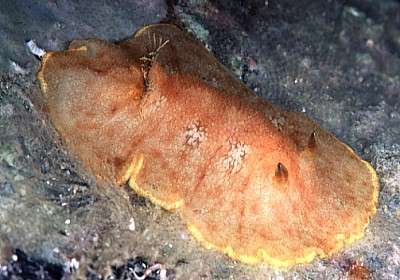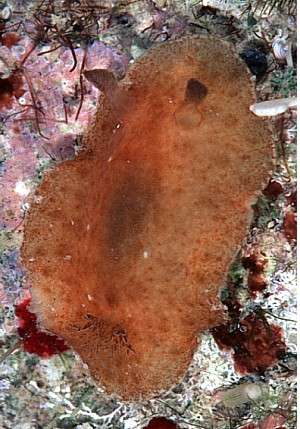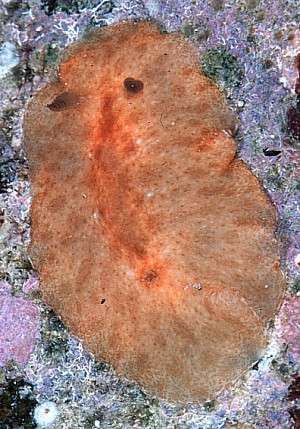Discodoris sp. 1.
Order: NUDIBRANCHIA
Suborder: DORIDINA
Superfamily: EUDORIDOIDEA
Family: Dorididae
This is a temporary page, until the photos below are better identified.
Authorship detailsRudman, W.B., 1999 (November 13) Discodoris sp. 1. [In] Sea Slug Forum. Australian Museum, Sydney. Available from http://www.seaslugforum.net/find/discsp1
Related messages
Platydoris? or Discodoris? from Kerama Is.
November 14, 1999
From: Atsushi Ono

Dear Bill,
Thank you for quick reply.
This time, I am worried about some Doridacea species. They are from Kerama Is.[near OKINAWA in JAPAN].
UPPER PHOTO: I think this is Discodoris sp., probably 'Milne Bay Discodoris in NUDIBRANCHS OF THE SOUTH PACIFIC [ by Neville Coleman]. This individual is about 35mm long, at 5m depth. It has yellow margin and a few blurred light patchs on its body. This species is showed as Discodoris sp.5 in my book. This is only found night-diving, and is a rare species at Kerama Is.
LOWER PHOTOS: I think these are the same spceis as the one above. They are only found at night-diving, 20-30mm long, at 3-7m depth. This species is showed as Discodoris sp.2 in my book. They have a few little white spots on their body(some have no spot). This is common species here at summer season. I think this is similar to Platydoris sanguinea of your Sea Slug Forum on the Dorid Head page.
Is my species
Could you help me identify for these species?
Sincerely,
Atsushi Ono
ononini@cosmos.ne.jp


Dear Atsushi,
Sorry it has taken me a while to answer this enquiry. There are a number of similarly coloured species belonging to the genera Discodoris and Platydoris. I am pretty sure this is a Discodoris as species of Platydoris have distinctively raised edges to the gill and rhinophore pockets, which I can't see in your photos.
Does animal have a hard and rigid mantle. like in the animal you have called Platydoris formosa in your book, or is it softer like in Discodoris lilacina?
Best wishes,
Bill Rudman.
